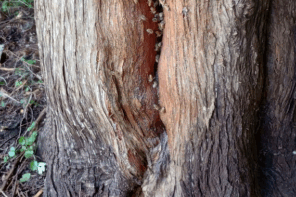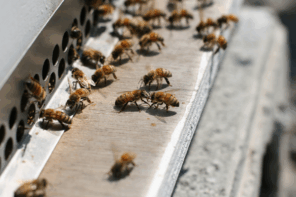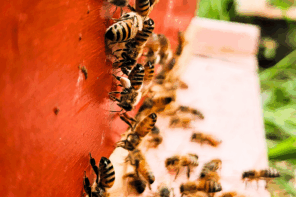By: Janice Sina
This article originally appeared in the Summer 2018 issue of BEEKeeping Your First Three Years
My rural honey bee colonies have access to hayfields, a sizable pond, a mixed hardwood forest, even a nursery brimming with potted plants, all within foraging distance. I watch plants bloom in turn throughout the season, from skunk cabbage to goldenrod, and never give much thought to water supply even on the hottest Summer days as the pond glimmers through the trees beyond the hives. Lucky bees. Living the life.
What about their urban cousins, I wondered? I picture car horns blaring, cement walkways and blacktop roadways. I’m dismayed at the polarity between the manicured, pest-free lawns with fountains spraying chlorinated water in front of office complexes, and empty lots strewn with weeds and muddy puddles on neglected streets. I can recall the acrid smell of fumes rising from exhaust pipes and sidewalk grates. Are there enough dandelions between the cracks in the sidewalks in March to coax honey bees out of their hives? Is there enough variety in the flower beds and window boxes, and in the trees lining the avenues? How, then, are beekeeping practices in the city different from those in the country?
To answer these questions I had to find some urban beekeepers and it turns out that schools are promising places to raise bees. To the adventurous of spirit, bees are intriguing and just daring enough. They appeal to ecologically minded and informed young adults who have a stake in what their world will be like 20 years from now. And their care ties neatly into ecology clubs that generally meet weekly.
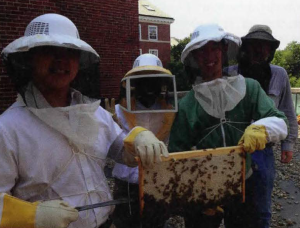
Harvard Undergraduate Beekeepers Club members working the hives on a Spring day. Photo by Greg Morrow
I made my way to Fairchild-Wheeler Regional Magnet School on an unusually warm October day, clean bee suit folded neatly in the back seat of my car, anticipating a foray into the hives, despite the threat of thunderstorms. Fairchild-Wheeler is located in Bridgeport, a city of about 146,000 citizens on the Connecticut shoreline, a little over 60 miles from New York City. Driving along I-95, surrounded by cars, trucks and concrete, I admittedly had a dismal outlook. The adrenaline rush of highway driving slowly subsided as I wound my way up the long driveway to the school, flanked by trees and open fields. I was escorted up to a third floor classroom by Dr. Watson, the vice principal, and placed in the care of Abby Kolakowski and Victoria LaGuardia just as the Ecology Club was getting underway. The room was its own hive of activity, each cluster of students focused on their own project. As the rains swept through and the bees stayed inside, Abby and Victoria took me out to the hallway where a floor-to-ceiling window revealed four hives nestled in an alcove on the third floor rooftop. A three-foot wall served as a windbreak and rock sedum carpeted the area. Looking beyond, I saw only trees. It was hard to imagine that the busy urban heart of Bridgeport pulsed just two miles away. The question in my notebook about forage dissolved into the Autumn colors.
Fairchild-Wheeler is a new green school with five rooftop gardens and two ground-level gardens at each end of the school. With the school’s location at the northern end of Bridgeport, these bees appeared as well fed as any rural bees.
Still, I needed more evidence. On to a much older school, one solidly grounded in history and viewed as the anchor of the city of Cambridge, MA – Harvard University. Here, old buildings are revered and preserved; any modernizations are carefully added so as to preserve its traditional appearance. I met with senior Walter Martin on the rooftop of Pforzheimer House, a five minute walk from Harvard Yard. Walter has been an active member of the club for four of its six years; he comes from a family of beekeepers in Maine. There was no need for a clean bee suit here either because at 42°F, it was just too cold to peek inside, though there were a few brave workers out on cleansing flights.
The thing about a settled city like Cambridge is that it’s, well, settled. Mature trees, the principle source of forage, are as much a part of Harvard as their massive buildings. Unfortunately, limited lawn space means few dandelions or clover, and the tightly packed maze of busy streets within foraging distance leaves little room for areas of goldenrod or asters, those weedy roadside sources of pollen and nectar so important for Fall feeding. Walter acknowledges that forage is sparse and unpredictable, and this isn’t good for bees.
Greg Morrow is the advisor to the Harvard Undergraduate Beekeepers Club and a beekeeper for over 50 years. He modestly gives credit to the students, citing club cofounders John Aloian, Li Murphy and Sarah Callan who reached out to researchers, faculty, businesses, and fellow students to establish the club in 2011, making it the only club at Harvard that manages livestock. Interestingly, the club didn’t start out with any live bees due to constraints from Environmental Health and Safety. The students learned about honey extraction and candle making in a Winter session with Maine’s State Beekeeper, at the time, Christie Hemenway, and trained in the basics of beekeeping before the first bees arrived. In time, the University recognized the group as an official club, its protocols approved by Environmental Health and Safety, and got its first grant from the Harvard University Center for the Environment for $1,000. With additional funding from the Office of Sustainability, they were ready for bees. They found Greg, who contributed not only bee-wisdom but veils, hive tools and hive boxes.
Both the students at Fairchild-Wheeler and at Harvard practice organic beekeeping to keep stress at a minimum. Neither club uses any chemical treatments. Walter says his Harvard bees have had very few problems with Varroa mites and mite-related viruses and this may be because there are fewer hives around for cross-contamination. That said, they also haven’t had much better success at overwintering than the average New England beekeeper. This may be due to the increased temperature swings on the rooftop, wind currents, and the inability to put up enough stores for winter despite supplemental feeding. This year, the club wants to try using an insulated black plastic product known as a “bee cozy,” and earlier Spring feeding. The students at Fairchild-Wheeler use drone frames and confectioners’ sugar to control mites. They supplement their feed with Honey-B-Healthy ®· I was surprised to learn they rarely if ever smoked the bees when working with them. They’re experimenting with sumac or burlap as natural alternatives to purchased smoker products. They too have had their share of troubles with Winter survival, employing tar paper, windbreaks and even straw in an empty box with a mesh bottom for moisture control.
Both schools also cite safety concerns as a limiting factor to the size and location of their apiary. There must be secured access to the hives to prevent injury to other students or to the bees themselves. Foraging flight paths must be considered also, but as Walter and many other beekeepers have observed, bees generally fly out and up as they leave the hive, minimizing contact with anyone directly below the roof. Proper protective gear must be provided to keep the student beekeepers safe, and proper training by a knowledgeable beekeeper takes time and commitment. All this must come from the club’s budget, either through dues, fundraisers or grants. It’s a pretty big learning curve for an extracurricular activity.
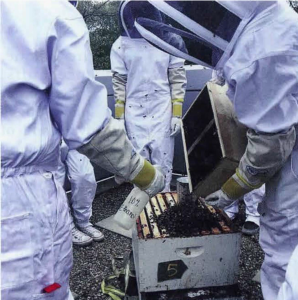
Students prepare for the installation on a new hive. No, it’s not really ethanol! Photo by Aby Kolakowski
But it’s not all uphill battles and losses. Fairchild-Wheeler harvested honey their first year and sold candles at a school fundraisers, raising awareness along with money. Abby recalls some funny stories. There are pictures showing their advisor spraying a new hive installation with sugar water in a bottle labeled 10% ethanol. The joke of course was all about drunken bees. On another occasion, a drone frame showed brood in the shape of ILY, the acronym for I Love You. They kept that for a long time. Maybe the bees were trying to tell them something. And Harvard beekeepers may have invented a new form of hazing, as recounted by Walter. As a freshman in his third week of school, he was recruited to help combine two weak hives, each with a queen, and only a layer of newspaper between them. To add to the challenge, they had to be transported to another building. The ride through Cambridge was fraught with speed-bumps, curious police officers tagging along, and some agitated bees barely contained in a laundry hamper. Once on site, the students had to carry the bees through the building and up the stairs to their new home before both freshmen and bees were initiated into the club.
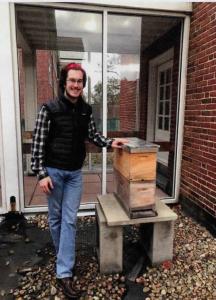
Senior Walter Martin on the rooftop of Pforzheimer House with a hive on a chilly November afternoon. Photo by Janice Sina.
Beekeeping clubs are unique, and not just for science buffs. Though the bottom line is to build a competent core of beekeepers that can oversee the livelihood of their charges, there are so many other facets of beekeeping. From honey extraction to candle making to assembling equipment, there’s something for everyone. In addition, school settings lend themselves to research. Using infrared sensors, students can collect data on hive temperatures, or they might research queen viability, Varroa mites and their viruses, or toxins brought in on pollen. The list is long and students are curious.
Though not directly used in their classroom studies in either school, some students at Fairchild-Wheeler, a STEM Magnet school, have done research on CCD as a Capstone Graduation project. At Harvard, the Biology department studied neonicotinoids and a photography class presented Portraits in Beekeeping. There are benefits that reach into every nook and cranny of learning. Abby says, “It teaches good problem solving skills and application-based learning. If a school can do it, they definitely should. It’s good for the bees, good for the students.”
There are a lot of unanswered questions and some of it is due to the discontinuity of the club members. School is, of course, their top priority. They graduate and move on, leaving threads dangling. It’s understandable, but not so advantageous for the bees. Li says, “Learning how to pass on knowledge is key. It’s hard to create continuity but fresh eyes are good too. It adds balance to the group.” And if urban beekeeping is going to grow and reach its potential, this is a great place to start. Kids collecting data, getting excited about an indicator species, one that has the potential to open a lot of eyes to the environmental concerns we are facing today.
This has a ripple effect, a tiny stone tossed from one club sending waves into the world. Li recalls her adventures in Thailand where bee fences surround farm fields. Bee fences? Top bar hives are suspended around farm fields to keep wandering elephants out of the fields. Apparently mice aren’t the only thing elephants don’t like. The benefits are clear. It reduces human-elephant conflict, provides honey for farmers, and increases pollination of crops.
Greg Morrow says, “I cannot underscore the importance of having a bee club at Harvard. [It] attracts a wonderful diversity of students, all of whom are enriched by the galaxy of knowledge gained from experiencing the biology of bees.” Listening to the students as they describe the challenges and heartbreaks, their funny stories and triumphs, I’m amazed at their resilience as much as I am always amazed at the resilience of the bees.
Janice Sina is a writer and beekeeper in East Haddam, CT. She welcomes the chance to mentor new beekeepers and trade beekeeping wisdom with seasoned beekeepers. You can contact her at janicesina.com.







